What's Old is New Again - Aircraft Carrier Deployment
25 May, 2018 | General News
Here's your Northern Fury flashback from the '90s: Where are the carriers?
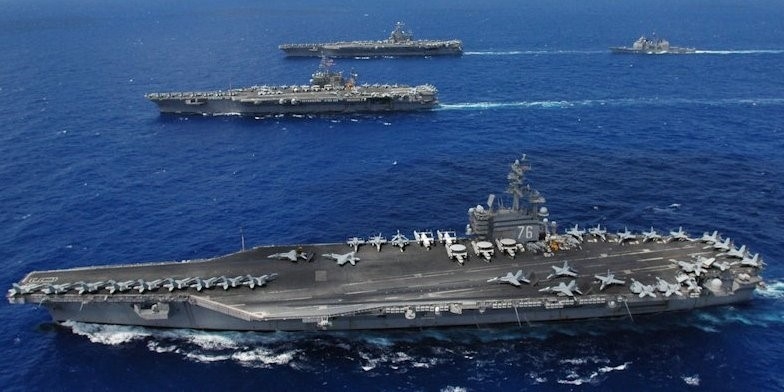
In another example of “What’s old is new again”, the US Navy is contemplating Dynamic Force Employment for its Aircraft Carriers. Essentially this is an effort to become less predictable while at the same time easing the maintenance and personnel toll of having its CSG (Carrier Strike Groups) on a fixed rotation. The current “predictable” plan was articulated in the Optimized Fleet Response Plan which was largely brought about by constrained resources, reduced crews and training backlogs. Today’s concerns over a resurgent Russia and Northern Fury’s continuation of the Cold War are quite similar.
Navies are expensive; they consume huge financial, material and human resources, and to be effective they need to be in the right place at the right time with the right training and in the right posture. Employing this force is ends up being a delicate balance of availability, finances, training and maintenance. Discussing better ways of deploying the force is a recurring theme in the USN’s (and most other navies’) history. The aircraft carrier, particularly for the USN, epitomises the combat power of the Navy as a whole and serves as an excellent barometer to measure employment mechanisms.
Perhaps it’s worthwhile to review how carriers operate. Here we will discuss US carriers; a future blog will compare how this differs with Soviet/Russian doctrine, and indeed with that of most other countries. First and foremost, an aircraft carrier does not operate alone, today, in Northern Fury or any time in the history of this ship type. In the Cold War, and certainly in Northern Fury, the aircraft carrier leads a Carrier Battle Group (CVBG). In the present day, the CVBG has been replaced by a much smaller Carrier Strike Group (CSG). A CSG is the carrier and its air wing normally accompanied by a guided missile cruiser (CG), two or three guided missile destroyers (DDG), probably an attack submarine (SSN), and joined by a replenishment ship from time to time. It can be larger, but rarely smaller than this.
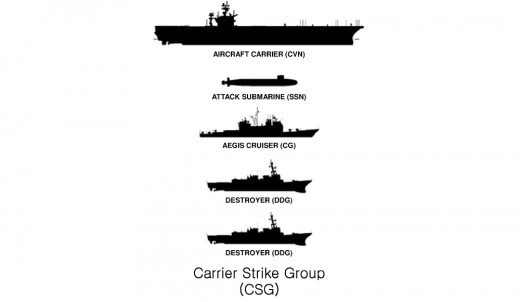
A CSG is smaller than a CVBG, partly because modern weapons and technology are more capable than they were in the 1980s and early ‘90s, but more importantly because the threat is much reduced. In either case, the purpose of the organization is to control an area or project combat power. The primary tool for projecting power is the aircraft carrier’s air wing (CVW), which has not changed dramatically over the 30 years, although the weapons the aircraft deliver have evolved significantly in that time. Some pundits claim we should bring the CVBG back now.
CVBG
The focal point of the US Navy in Northern Fury is the CVBG. Whenever we speak about carriers in the books or scenarios, we really mean the carrier, its aircraft, its escorts and its sailors; together they all make up the CVBG. During the Cold War, when air, surface and sub-surface threats were very high, a CVBG would be expected to survive at sea for weeks or months at a time in order to control sea-space and strike at enemy targets. To do this, these battle groups are extremely well defended as outlined at this link, (search for: aircraft-carrier-invulnerability) and formed one of the most powerful naval forces in the world. So let’s see what’s inside a CVBG.
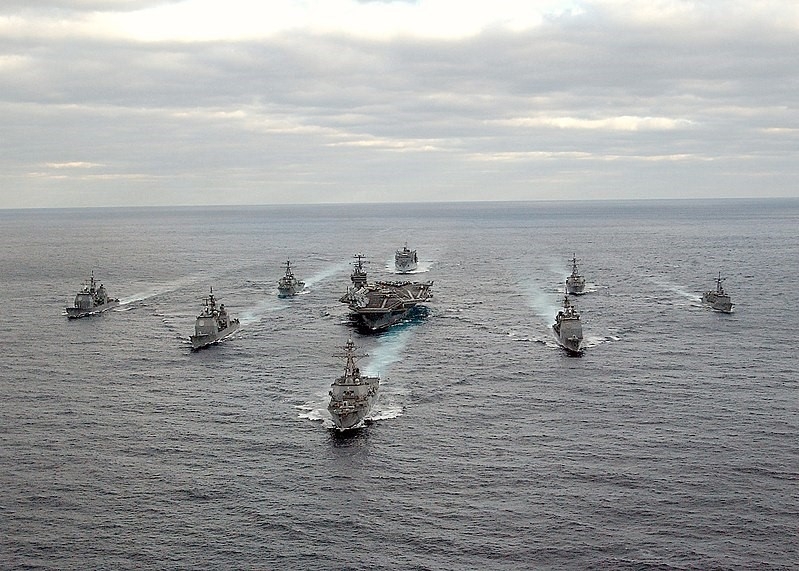
- The Aircraft Carrier. In 1994 there was a mix between conventionally powered (CV) and nuclear powered (CVN) carriers. For our purposes here, they should be considered equivalent, although size, age and fuel consumption are critical factors at the tactical level.
- Air Defence Escort. Usually in the form of 2-3 CG, or nuclear powered cruisers (CGN). By 1994 this would almost certainly include an AEGIS cruiser of the CG-52 type (Ticonderoga-class, Baseline 2) with a vertical Launch missile system (VLS), and one or more of the nine CGNs, an older CG of the Belknap-class (9 ships), Leahy-class (9 ships) or an earlier CG-47 type (Ticonderoga Baseline 0 or 1(6 and 5 ships). The newly built DDG-51 Arleigh Burke-class destroyers are also an option to fulfill this role.
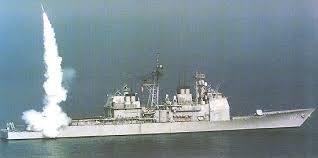
- Anti-Submarine Warfare (ASW) Escort. A mix of 3-5 destroyers (DD), DDG or Guided Missile Frigates (FFG) will fulfill this vital role along with their embarked helicopters. Occasionally a Knox-class Frigate (FF) will be found in a CVBG but these ships are not designed for the role and are barely capable of performing it. Allied navies routinely provide frigates or destroyers to augment the ASW force but there will always be at least one USN ship in this group. Spruance-class DDs with a VLS system will also provide a potent strike capability with their Tomahawk Land Attack cruise Missiles (TLAM), but their primary role is usually ASW.
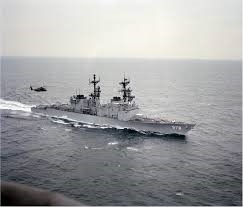
- Submarine Escort. One or two SSN will normally accompany a CVBG but will operate independently to achieve a distant screen. They provide early warning and possibly strike capability at a significant distance, often more than 1-200 nautical miles from the carrier. The Submarines will be under the lose control of the CVBG commander but due to a limited ability to communicate without exposing the SSNs presence, they will have much more autonomy than the surface ships of the group.
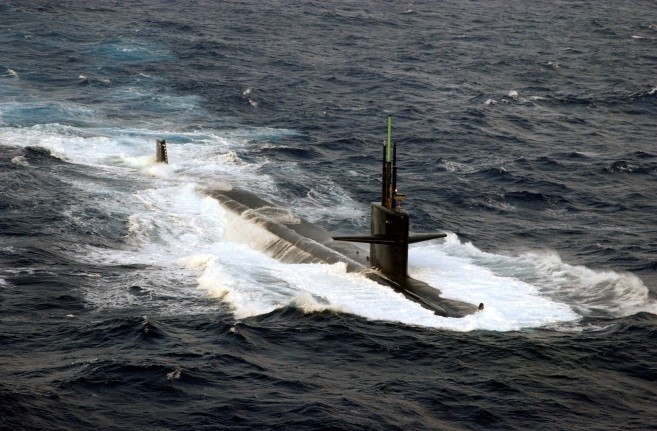
- Replenishment Ship(s). To keep a force the size and complexity of a CVBG at sea for weeks at a time requires significant effort and planning. The much quoted “An army marches on its stomach” maxim of Napoleon’s time applies tenfold to modern navies. Food is a factor, but is dwarfed in significance to fuel, ammunition and spare parts to keep the thousands of different systems operating within the battle group. Typically a CVBG would be accompanied by an AOE (Fast Combat Support Ship) of the Sacramento (AOE-1-class) or Supply (AOE-6-class) types; however, only seven of these ships exist; and that is counting an accelerated deployment of the Supply-Class in Northern Fury. The AOE would itself be replenished by other ships providing fuel, ammunition, dry goods and spare parts from ports around the world. A detailed discussion of the replenishment ships available will be the subject of another Blog, but suffice it to say a vast array of ships are required to keep CVBGs at sea.
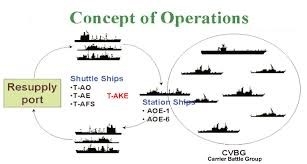
- Carrier Air Wing (CVW). This is the real striking power of a CVBG. The wiki page at this link outlines the history of the CVWs in the USN, and in Northern Fury they largely conform to the example for the 1991 Gulf War, with one major exception. In Northern Fury the A-6E Intruder is being retired early in order to save costs and maintain additional CVWs active. You will note in the Wiki that the US currently operates nine CVW, and you may know that in 2018 there are 11 CVNs. Why the discrepancy? Simply put, there is always at least one Carrier in Dry-dock and another being refitted at any time, and these do not need aircraft. In Northern Fury there are 15 CV/CVNs active in the fleet, and 13 CVW. Although the CVW differ slightly from carrier to carrier the standard composition in Northern Fury is:
- 2 fighter squadrons (VF) of 12x F-14 Tomcats;
- 2 strike fighter squadrons (VFA) of 12x FA-18 Hornets;
- 1 early warning squadron (VAW) of 4x E-2C Hawkeyes;
- 1 tactical electronic warfare squadron (VAQ) of 4x EA-6B Prowlers;
- 1 anti-submarine squadron (VS) of 8x S-3A Vikings;
- 1 helicopter ASW squadron (HS) of 6x SH-3H Sea Kings or 6 SH-60F and 2 HH-60H Seahawks;
- 1 Detachment of ELINT ES-3A Shadows from a fleet air reconnaissance squadron (VQ);
- 1 detachment of C-2A Greyhound aircraft for Carrier Onboard Delivery (COD)
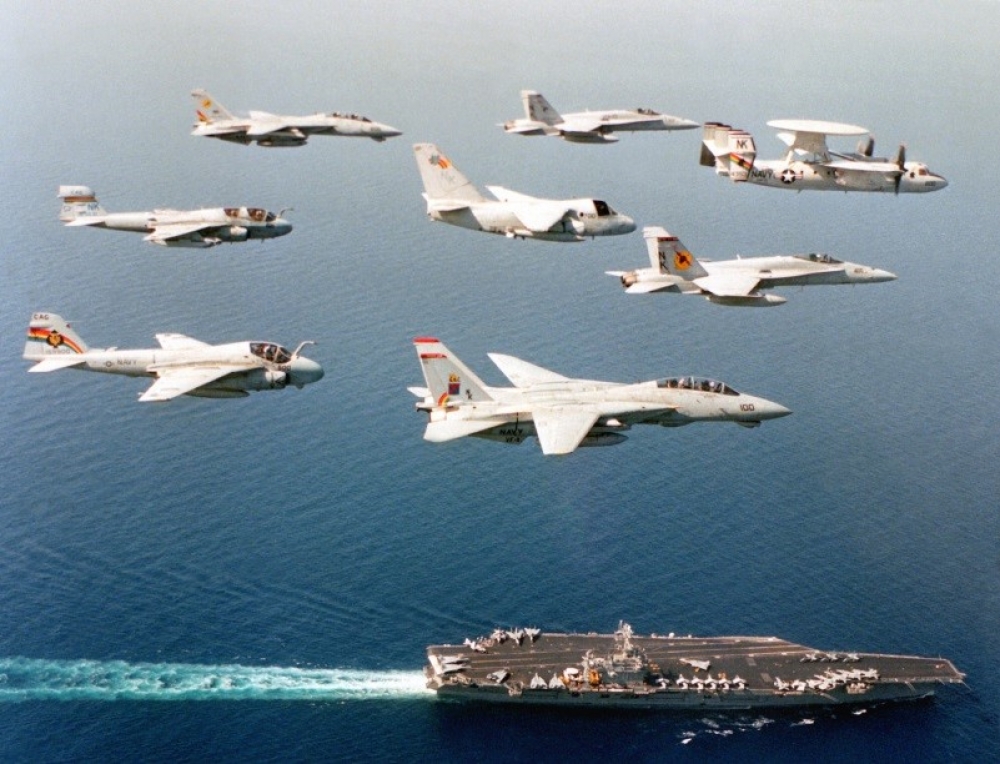
The Carriers
First let me reassure you that not all of the detail outlined below will be in the books, but we’ve thought about it and developed a story line that we hope is believable, realistic and practical. The key tidbits will appear in print but most of the data will reside on the web page. We don’t want to overburden the story-line or casual reader, but at the same time we aim to satisfy the true Grognards as best we can.
As mentioned above, there are 15 Carriers commissioned in Northern Fury while historically in 1994 there were 13. How does that happen? There are three main reasons:
- Aircraft Carriers, their CVW and battle group are very expensive so were one of the first items on the chopping block at the end of the Cold War. Since that Cold War didn’t end in Northern Fury, the chopping block was not used as much.
- A key feature of the “600 Ship Navy” Policy instituted in the early ‘80s was to have 15 CVBGs (page 25 of the link has a decent chart, replicated here).
- With only a few relatively minor adjustments to the timelines; the ships were physically available. Historic dispositions can be found here. The two additional retentions are the Forrestal as a flight training ship and the Ranger in active reserve with a skeleton crew. The Midway and Coral Sea replaced these two in ‘Inactive Reserve’.
So in February 1994 according to the Northern Fury timeline the Aircraft Carriers and their status is:
- CV-41, Midway: Inactive Reserve since returning from deployment to the Gulf War, Apr 92.
- CV-43, Coral Sea: Inactive Reserve since returning from deployment to the Med, Apr 90.
- CV-59, USS Forrestal: Retained in commission as flight training platform.
- CV-60, USS Saratoga: On active deployment in the Indian Ocean. Home Port San Diego.
- CV-61, USS Ranger: Active Reserve with limited crew, Bremerton, Wash since Jul 93.
- CV-62, USS Independence: At Sea – Forward Deployed to Yokosuka, Japan.
- CV-63, USS Kitty Hawk: Routine maintenance, Home Port San Diego.
- CV-64, USS Constellation: At Sea – Philippines, Home Port San Diego.
- CVN-65, USS Enterprise: At Sea – Workups near Puerto Rico, Home Port Norfolk.
- CV-66, USS America: Dry dock – Newport News, Home Port Norfolk.
- CV-67, USS John F. Kennedy: At Sea – Caribbean, Home Port Lake Charles LA.
- CVN-68, USS Nimitz: On active deployment in the Indian Ocean, Home Port San Diego.
- CVN-69, USS Dwight D. Eisenhower: At Sea – Mediterranean, Home Port Norfolk.
- [CVN-70](/blog/CVN-65 Enterprise - under construction), USS Carl Vinson: Routine maintenance, Home Port Norfolk.
- CVN-71, USS Theodore Roosevelt: Minor refit, Home Port Norfolk.
- CVN-72, USS Abraham Lincoln: At Sea – Australia en-route to Gulf, Home Port San Diego.
- CVN-73, USS George Washington: In Port – Home Port San Diego.
- CVN-74, PCU John C. Stennis: Completing Construction, Newport News
Both Ranger and Forrestal will take 30-60 days to be made ready of operations. The Independence has forgone her annual refit period due to the increased tensions. Theodore Roosevelt is due to remain in overhaul for a further 60 days but can be made ready in 7-10 days. The Saratoga is due for a six-month refit and the Abraham Lincoln is due for a three-month overhaul upon return from deployment to the Indian Ocean. The America was placed in dry-dock refit upon return from a nine-month deployment and will be laid up for four months.
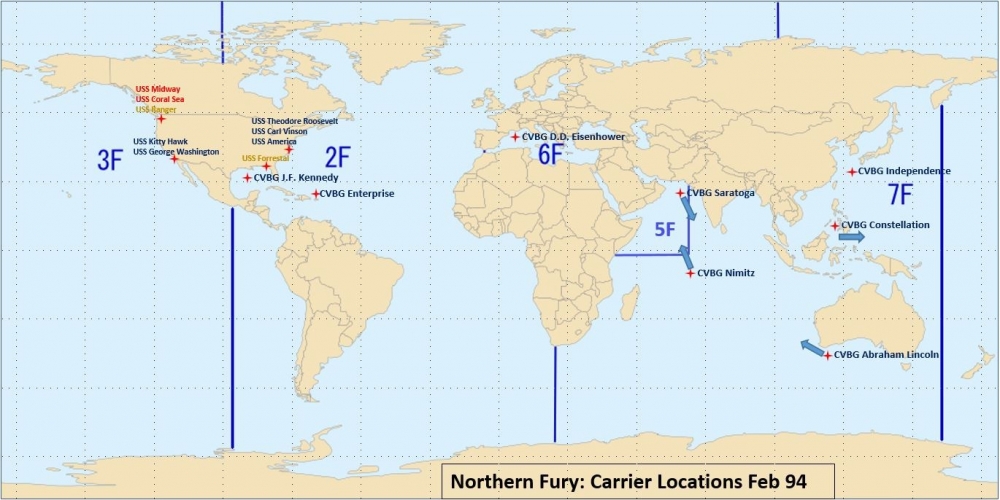
Why so many?
This is the question that has haunted the US Navy for decades: How to justify the numbers to the US Congress who authorizes the funds to build, maintain and operate the fleet? This link will bring you to an excellent (if lengthy) paper (Newport Paper #33) from the US Naval War College. Page 27-29 explains the justification (in the early ‘80s) for 22 CVBGs, and on page 30, the outline plan for employment of the 11 (of 14) available CVBGs in the first weeks of the war. The nub of the plan, which carries through to Northern Fury, would be for three CVBGs reinforced by another two in the North Atlantic, with one more protecting the Line of Communications to Europe, while four would be needed in the Mediterranean and three would hold in the Pacific until an eventual eight or nine would gather there. Clearly prioritization and sequencing would be required.
Of more specific interest to Northern Fury is the justification for the ‘600 Ship Navy’ which can be found on pages 246-258. Although biased towards the plan, this section is concise and convincing.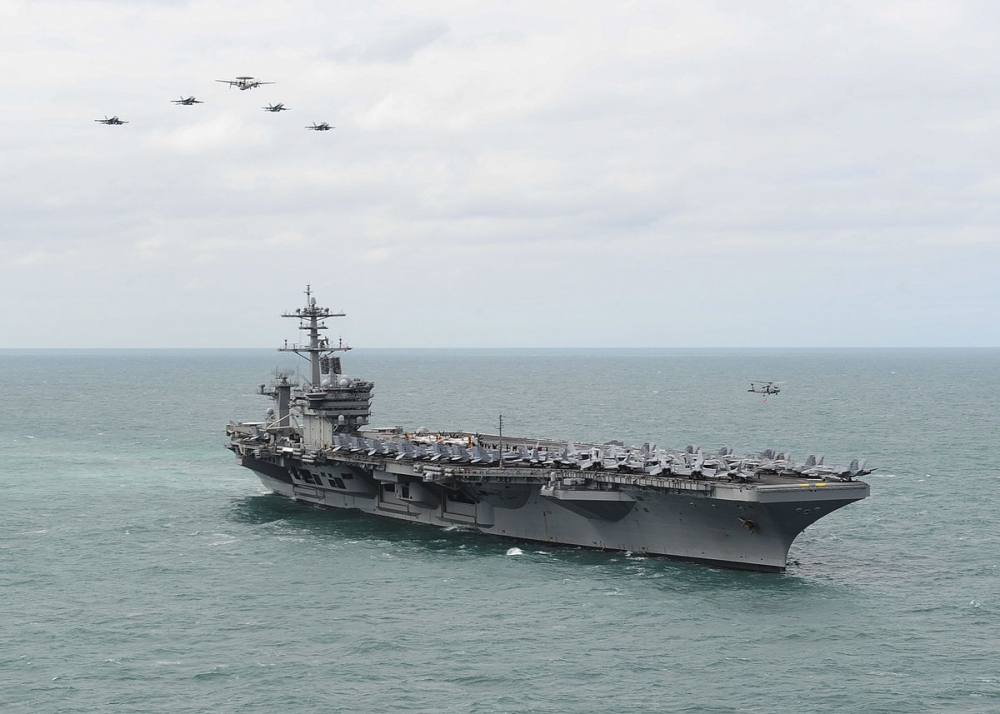
Northern Fury
So in our story the initial situation does not seem to reflect the standard planned deployment. There are no CVBGs in the North Atlantic, the Western Pacific is looking a little thin and the customary (if illogical) presence of a carrier in the Persian Gulf is absent. Without going into the details, there are reasons for these anomalies and it comes down to balancing risk. The primary purpose of naval forces in peacetime is deterrence, a show of force and the determination to use it; essentially the US chose a time and place to show that force – and was wrong. Following this gamble there is a short time required to “reset” the disposition, and this is the moment we are in when the Soviets make their move. Unfortunate, but makes for a good story! In a nutshell:
- The Eisenhower and America have just switched places, Ike in the Mediterranean and the America in dry-dock. Ike participated in the demonstration alluded to en-route to its deployment.
- The Carl Vinson and the Eisenhower, were the main players in the show of force in the Atlantic. Now the Vinson needs to conduct some routine maintenance.
- The Theodore Roosevelt is wrapping up a refit in Norfolk
- The Enterprise completed her “Refueling and Complex Overhaul” (RCOH), nine months early. This is due primarily because I wanted her as part of our story, but also in response to the increased tensions. We have a complete timeline for her and she is now conducting workups in Puerto Rico. She will be diverted to the North Atlantic as a precautionary move just prior to hostilities breaking out.
- The John F. Kennedy is temporarily stationed at Naval Station Lake Charles Louisiana and has been operating in the Gulf of Mexico and Caribbean for the past year to deter any aggression from increasingly hostile countries in the region.
- In the Pacific, the Independence did not go for her annual refit, instead, she conducted a major exercise with the Abraham Lincoln simultaneous with the Constellation participating in an extended training program with the evolving Philippine Navy.
- The Lincoln then moved south to spend a couple weeks training with the Australians and is now heading to relieve both Nimitz and Saratoga in the Persian Gulf region.
- Nimitz departed the Persian Gulf early to conduct unexpected repairs at Diego Garcia and will head back to the West Coast once the Lincoln arrives.
- The Saratoga was west of Australia when the Nimitz departed the Gulf and is heading through the Arabian Sea to take her place in those narrow waters.
- Keen followers of the USN will note that the Carl Vinson should be home ported on the West Coast while the George Washington should be in 2nd Fleet. In Northern Fury the Vinson and the (not decommissioned) Saratoga switched ports to maintain the more powerful CVN in the Atlantic; so Vinson moved to the East Coast in 1990 before her Complex Overhaul (COH) and remained, while the George Washington moved west upon commissioning to balance the fleet.
carrierbattlegroupunderwayc1992_1_o.jpg)
Balancing the employment of the fleet through use and deployment of the aircraft carriers is not new in the USN. It is simply a mechanism to juggle competing resources and commitments and has been going on for decades.